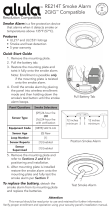
CO can be produced when burning any fossil fuel: gasoline, propane, natural
gas, oil and wood. It can be produced by any fuel-burning appliance that is mal-
functioning, improperly installed, or not ventilated correctly, such as:
Possible sources include furnaces, gas ranges/stoves, gas clothes dryers, water
heaters, portable fuel burning space heaters, fireplaces, wood-burning stoves
and certain swimming pool heaters. Blocked chimneys or flues, back drafting
and changes in air pressure, corroded or disconnected vent pipes, or a loose or
cracked furnace exchanger can also release CO into your building. Vehicles and
other combustion engines running in an attached garage and using a charcoal/
gas grill or hibachi in an enclosed area are all possible sources of CO.
The following conditions can result in transient CO situations:
Wind direction and/or velocity, including high gusts of wind, heavy air in the
vent pipes (cold/humid air with extended periods between cycles), negative
pressure differential resulting from the use of exhaust fans, simultaneous opera-
tion of several fuel-burning appliances competing for limited internal air, vent
pipe connections vibrating loose from clothes dryers, furnaces, or water heaters,
obstructions in, or unconventional, vent pipe designs which can amplify the
above situations, extended operation of unvented fuel-burning devices (range,
oven, fireplace, etc.), temperature inversions which can trap exhaust gasses near
the ground, car idling in an open or closed attached garage, or near a home.
CO SAFETY TIPS
Every year, have the heating system, vents, chimney and flue inspected and
cleaned by a qualified technician. Always install appliances according to manu-
facturer’s instructions and adhere to local building codes. Most appliances
should be installed by professionals and inspected after installation. Regularly
examine vents and chimneys for improper connections, visible rust, or stains,
and check for cracks in furnace heat exchangers. Verify that the color of flame
is blue on pilot lights and burners. A yellow or orange flame is a sign that the fuel
is not burning completely and may be releasing CO. Teach all household members
what the alarm sounds like and how to respond. Fire Departments, most utility
companies and HVAC contractors will perform CO inspections, some may charge
for this service. It’s advisable to inquire about any applicable fees prior to having
the service performed. Kidde will not pay for, or reimburse the owner or user of
this product, for any repair or dispatch calls related to the alarm sounding.
SYMPTOMS OF CO POISONING
Initial carbon monoxide poisoning symptoms are similar to the flu with no fever
and can include dizziness, severe headaches, nausea, vomiting and disorienta-
tion. Everyone is susceptible but experts agree that unborn babies, pregnant























